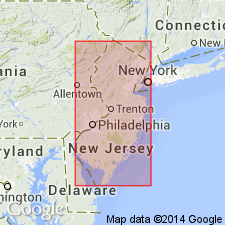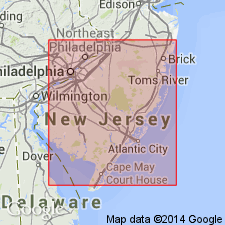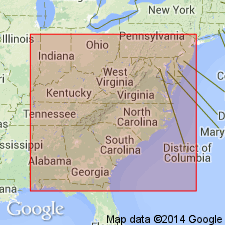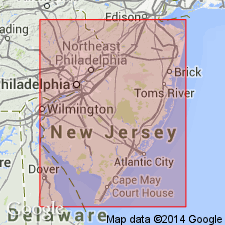
- Usage in publication:
-
- Kirkwood Formation
- Modifications:
-
- Revised
- Dominant lithology:
-
- Sand
- Clay
- AAPG geologic province:
-
- Atlantic Coast basin
Summary:
A coastal plain marine formation of middle Miocene age deposited disconformably on a highly eroded surface of lower Tertiary greensands and limesands. Maximum outcrop thickness is about 100 ft. Updip it progressively overlaps older units (Manasquan and Vincentown Formations and the Hornerstown Sand). Overlain by the Cohansey Sand. May be divided into three members: Grenloch Sand Member, Asbury Park Member, and Alloway Clay Member. All three members, though easily distinguished in outcrop, rapidly lose their identity downdip and cannot be differentiated lithologically in deep wells. Correlated with the middle Miocene Calvert Formation of MD and VA based on the fauna of the Shiloh Marl bed of the Alloway Clay Member (Bernstein, M.R., 1984, Northeastern Geology, v. 6, no. 3, p. 175).
Source: GNU records (USGS DDS-6; Reston GNULEX).

- Usage in publication:
-
- Kirkwood Formation
- Modifications:
-
- Revised
- AAPG geologic province:
-
- Atlantic Coast basin
Summary:
Kirkwood Formation. Formally divided into Alloway Clay Member, Grenloch Sand Member (new), and Asbury Park Member.
Source: Modified from GNU records (USGS DDS-6; Reston GNULEX, Asbury Park entry).

- Usage in publication:
-
- Kirkwood Formation*
- Modifications:
-
- Overview
- AAPG geologic province:
-
- Atlantic Coast basin
Summary:
Kirkwood Formation shown in NJ on several lithologic sections as early Miocene age. Correlation with calcareous nannofossil zones in not known. Overlies late Paleocene Vincentown Formation, late Paleocene and early Eocene Manasquan Formation, or Eocene Shark River Formation; underlies middle Miocene Cohansey Sand or late(?) Miocene unnamed conglomerate. Report includes fossil lists and stratigraphic/lithologic sections.
Source: GNU records (USGS DDS-6; Reston GNULEX).

- Usage in publication:
-
- Kirkwood Formation*
- Modifications:
-
- Revised
- Redescribed
- AAPG geologic province:
-
- Atlantic Coast basin
Summary:
Kirkwood Formation. Subdivided into (descending): Belleplain Member (new), Wildwood Member (new), Shiloh Member, and unnamed lower member. Age is Miocene.
Source: Publication.
For more information, please contact Nancy Stamm, Geologic Names Committee Secretary.
Asterisk (*) indicates published by U.S. Geological Survey authors.
"No current usage" (†) implies that a name has been abandoned or has fallen into disuse. Former usage and, if known, replacement name given in parentheses ( ).
Slash (/) indicates name conflicts with nomenclatural guidelines (CSN, 1933; ACSN, 1961, 1970; NACSN, 1983, 2005, 2021). May be explained within brackets ([ ]).

